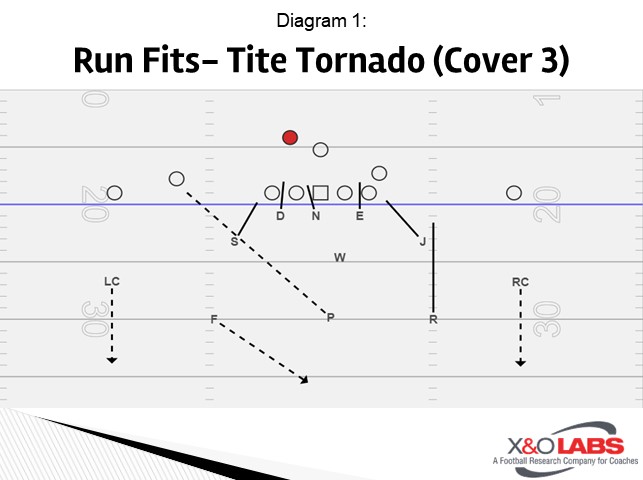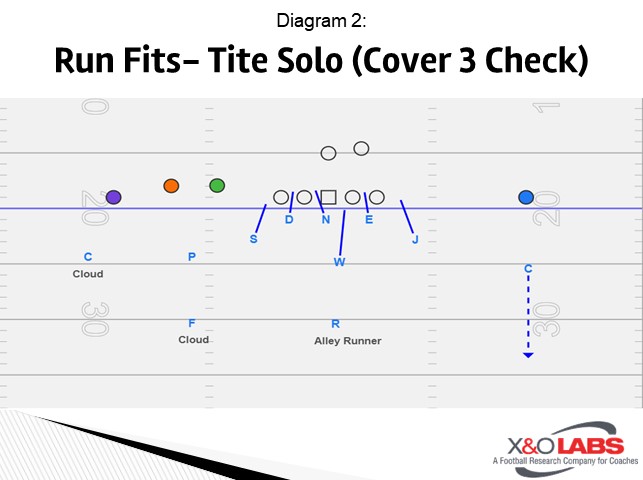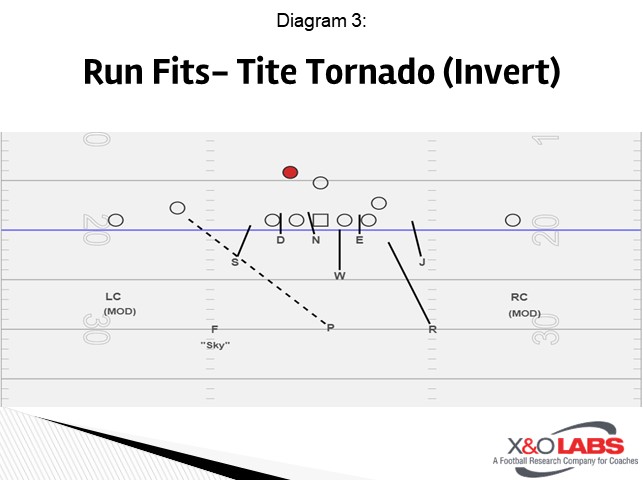By Chris Bunting
Defensive Coordinator & Safeties
Millbrook High School (NC)
Twitter: @bunting36
Here at Millbrook, when I was hired here, we transitioned away from a 4-2-5 look. We installed a 3-4 mostly due to a lack of quality depth at the defensive line. Our 2019 defensive line had 2 starters that weighed 205 or less. We also knew we would have a lot of “tweener” type guys. Our 3-4 has given us lots of answers, but not all that we need. When looking for answers to stop Air Raid offenses, defend RPO’s, and to find ways to win 3rd down, we looked at incorporating a 3 high safety package. Our Psycho package accounted for 25% of all calls in 2019 and we gave up almost 1 yard/play fewer than our base package calls. We used it predominantly for 2nd & long or 3rd down calls, though it can be far more than that. We used it as our primary package against an RPO-heavy conference opponent to limit the conference offensive player of the year at wide receiver. We also used it as a major part of our game plan against the eventual state runner-up in the highest classification in NC. We held that team, averaging 32 pts/game, to only 4 field goals. In this report, we will discuss our run fits out of the Psycho package.
Installation:
Our goal when implementing our Psycho package is for simplicity to win out. We want to limit any new teaching that needs to occur. We want guys playing techniques they know and allow them to play fast. When we meet as a staff, I always ask position coaches how we can teach concepts with our terminology & minimize confusion. Because of our 3-4 structure, we only must teach one new position when we transition to our Psycho package- our Prowler (P) who replaces a linebacker. We use Hudl to share installs, we draw it up on the board in our Monday install meeting, and we include drawings in our scouting reports during the season. The only time investment we use on the field is during our group time (9 on 8 run period, ½ field pass, 7v7, etc.) or during team time.
STRUCTURE
We keep our run fits the same as our base defense when possible. Again, we want guys playing what they know and limiting over-thinking. We use our Prowler as the replacer when needed for overload pressures or sim pressures. Our Tite front was used on 56% of all calls out of our Psycho package, so, we will use that front when discussing how to defend RPO’s.
Position Responsibilities:
D- Devil is field side defensive end in a 4i. Responsible for strong side ‘B’ gap.
N- Nose either in a strong shade or 0 tech & slanting to the strength. Responsible for the strong side ‘A’ gap.
E- Edge is the boundary side defensive end in a 4i. Responsible for the weak-side ‘B’ gap.
W- Will linebacker is our plugger. Responsible for the weak-side ‘A’ gap.
S- Sam linebacker is our field-side overhang. Responsible for strong side ‘C’ gap and has seam/curl responsibilities in Cover 3. Force player with seam/curl responsibilities in Invert (Quarters).
J- Jack linebacker is our boundary side overhang. Responsible for the weak-side ‘C’ gap and has seam/curl responsibilities in Cover 3. Force player with seam/curl responsibilities in Invert (Quarters).
LC- Left corner, will know coverage from the nearest safety.
RC- Right corner, will know coverage from the nearest safety.
F- Free safety is our field-side safety. We will play the post in Cover 3. Communicates coverage to the nearest corner and makes all coverage checks.
R- Rover is our boundary safety. Communicates coverage to the nearest corner.
P- Prowler is our middle safety and is like our queen in chess. He is the RPO player for us and has the freedom to move around. He is the adjuster for trips checks and replaces linebackers on overload or sim pressures.
Pressure Patterns
TITE TORNADO (Cover 3 variation)
Tornado is our RPO coverage and we change up how we play it is based on our opponent’s tendencies or formations. In Cover 3, we like to play our Sam & Jack a little tighter to the box unless we get a Trips check. Against Trips, we can give the Jack multiple calls. He can play base, he can pressure through the ‘C’ gap, or he plays ‘Walk” technique where he walks out to jam the #1 receiver. Whichever Safety is playing the post is also an alley runner in run fits. The Prowler will be the force player to the RPO threat.

Against Trips formations, we keep the box intact and adjust with the safeties. We have multiple Cover 3 checks for Trips, but this was our most common check this past year based on our personnel’s abilities.

TITE TORNADO (Invert variation)
Invert allows us to play quarters and still have the RPO defender we need. We will play our Sam & Jack a little looser and allow our safeties to insert. The Rover will now have the boundary ‘C’ gap.

Playing Invert allows us to get an extra body on the H side while getting some pass help to the RPO side. We play by our ‘Sky’ quarters rules where corners are MOD (man on deep) and safeties take #2 receivers vertically or play post/dig/curl of #1. The Prowler is still the RPO player as well.
OTHER VARIATIONS
We can also pressure to maintain gap integrity and still play our coverage rules. In the next diagram, we call an overload pressure in the boundary and get the same Cover 3 run fits as shown earlier.

Defensive Coordinator & Safeties
Millbrook High School (NC)
Twitter: @bunting36
Here at Millbrook, when I was hired here, we transitioned away from a 4-2-5 look. We installed a 3-4 mostly due to a lack of quality depth at the defensive line. Our 2019 defensive line had 2 starters that weighed 205 or less. We also knew we would have a lot of “tweener” type guys. Our 3-4 has given us lots of answers, but not all that we need. When looking for answers to stop Air Raid offenses, defend RPO’s, and to find ways to win 3rd down, we looked at incorporating a 3 high safety package. Our Psycho package accounted for 25% of all calls in 2019 and we gave up almost 1 yard/play fewer than our base package calls. We used it predominantly for 2nd & long or 3rd down calls, though it can be far more than that. We used it as our primary package against an RPO-heavy conference opponent to limit the conference offensive player of the year at wide receiver. We also used it as a major part of our game plan against the eventual state runner-up in the highest classification in NC. We held that team, averaging 32 pts/game, to only 4 field goals. In this report, we will discuss our run fits out of the Psycho package.
Installation:
Our goal when implementing our Psycho package is for simplicity to win out. We want to limit any new teaching that needs to occur. We want guys playing techniques they know and allow them to play fast. When we meet as a staff, I always ask position coaches how we can teach concepts with our terminology & minimize confusion. Because of our 3-4 structure, we only must teach one new position when we transition to our Psycho package- our Prowler (P) who replaces a linebacker. We use Hudl to share installs, we draw it up on the board in our Monday install meeting, and we include drawings in our scouting reports during the season. The only time investment we use on the field is during our group time (9 on 8 run period, ½ field pass, 7v7, etc.) or during team time.
STRUCTURE
We keep our run fits the same as our base defense when possible. Again, we want guys playing what they know and limiting over-thinking. We use our Prowler as the replacer when needed for overload pressures or sim pressures. Our Tite front was used on 56% of all calls out of our Psycho package, so, we will use that front when discussing how to defend RPO’s.
Position Responsibilities:
D- Devil is field side defensive end in a 4i. Responsible for strong side ‘B’ gap.
N- Nose either in a strong shade or 0 tech & slanting to the strength. Responsible for the strong side ‘A’ gap.
E- Edge is the boundary side defensive end in a 4i. Responsible for the weak-side ‘B’ gap.
W- Will linebacker is our plugger. Responsible for the weak-side ‘A’ gap.
S- Sam linebacker is our field-side overhang. Responsible for strong side ‘C’ gap and has seam/curl responsibilities in Cover 3. Force player with seam/curl responsibilities in Invert (Quarters).
J- Jack linebacker is our boundary side overhang. Responsible for the weak-side ‘C’ gap and has seam/curl responsibilities in Cover 3. Force player with seam/curl responsibilities in Invert (Quarters).
LC- Left corner, will know coverage from the nearest safety.
RC- Right corner, will know coverage from the nearest safety.
F- Free safety is our field-side safety. We will play the post in Cover 3. Communicates coverage to the nearest corner and makes all coverage checks.
R- Rover is our boundary safety. Communicates coverage to the nearest corner.
P- Prowler is our middle safety and is like our queen in chess. He is the RPO player for us and has the freedom to move around. He is the adjuster for trips checks and replaces linebackers on overload or sim pressures.
Pressure Patterns
TITE TORNADO (Cover 3 variation)
Tornado is our RPO coverage and we change up how we play it is based on our opponent’s tendencies or formations. In Cover 3, we like to play our Sam & Jack a little tighter to the box unless we get a Trips check. Against Trips, we can give the Jack multiple calls. He can play base, he can pressure through the ‘C’ gap, or he plays ‘Walk” technique where he walks out to jam the #1 receiver. Whichever Safety is playing the post is also an alley runner in run fits. The Prowler will be the force player to the RPO threat.

Against Trips formations, we keep the box intact and adjust with the safeties. We have multiple Cover 3 checks for Trips, but this was our most common check this past year based on our personnel’s abilities.

TITE TORNADO (Invert variation)
Invert allows us to play quarters and still have the RPO defender we need. We will play our Sam & Jack a little looser and allow our safeties to insert. The Rover will now have the boundary ‘C’ gap.

Playing Invert allows us to get an extra body on the H side while getting some pass help to the RPO side. We play by our ‘Sky’ quarters rules where corners are MOD (man on deep) and safeties take #2 receivers vertically or play post/dig/curl of #1. The Prowler is still the RPO player as well.
OTHER VARIATIONS
We can also pressure to maintain gap integrity and still play our coverage rules. In the next diagram, we call an overload pressure in the boundary and get the same Cover 3 run fits as shown earlier.









